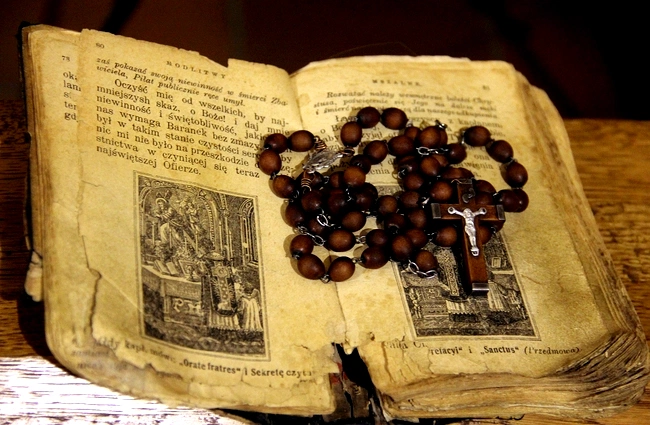
In several apparitions, Our Lady herself indicated the prayer of the rosary as the most necessary for humanity. Reproduced here is a fragment of Gabriel Amorth’s book “My Rosary: An Exorcist’s Beloved Prayer”.
The origin of the rosary dates back to the monasteries. In ancient times, the monks used to recite all 150 Psalms of David. However, it was challenging for both the monks and the faithful who attended the liturgies to memorize all the Psalms. Around the year 850, an Irish monk suggested substituting the recitation of the Psalms with 150 Our Fathers. This proposal gained acceptance, and the faithful, as well as the monks, began to count their prayers in various ways. Some used pebbles, others employed strings, and some even prayed with knots. Over the years, these knots and pebbles evolved into what we know as the rosary.
Its name was conceived in the twelfth century by the Cistercian monks. They referred to it as the rosary because they likened it to a crown of mystical roses offered to the Blessed Virgin Mary. Soon after, St. Dominic popularized the rosary. Moreover, he recognized its potential as a powerful tool for Christians to combat heresies.
However, the Mysteries as we know them today were not yet fully developed at that time. It was in the thirteenth century that theologians, inspired by the study of the 150 Psalms, began to see them as veiled prophecies about the life of Jesus. This exploration of the Psalms eventually led to the formulation of psalters focused on Jesus and dedicated to Mary. As a result, four distinct psalters were developed: one consisting of 150 Our Fathers, another with 150 angelic greetings, a third containing 150 praises of Jesus, and a fourth with 150 praises of Mary.
Around the year 1350, the Hail Mary prayer took shape as we know it today. Its development can be attributed to the Carthusian monks who combined the angel Gabriel’s greeting (“Hail Mary, full of Grace…”) with Elizabeth’s words (“Blessed art thou among women…”) and added “… now and at the hour of our death. Amen.”
In the fourteenth century, particularly among the Cistercians in the region of Trèves (now Trier) in France, additional clauses were inserted after the name of Jesus to encompass the life of Christ within the prayer. During the mid-fourteenth century, a monk named Henry of Kalkar from the Carthusian monastery in Cologne introduced the practice of reciting one Our Father before each decade. This method quickly gained popularity and spread throughout Europe.
Still in the Carthusian monastery of Trèves, at the beginning of the 1400s, Dominic Hélion – also known as Dominic the Prussian or Dominic of Trèves – developed a rosary, in which he succeeded the name of Jesus with fifty passages that retraced his life. Similar to what Henry of Kalkar introduced, Dominic the Prussian’s thoughts were divided into groups of ten with an Our Father at the beginning of each group.
Between 1435 and 1445, Dominic composed 150 passages for the Flemish Carthusian lay brothers who recited the Psalter of Mary. These passages were divided into three sections corresponding to the Gospels of Christ’s infancy, his public life, and the Passion-Resurrection.
In 1470, the Dominican Alan de la Roche, who had learned how to recite the rosary from the Carthusians, established the first Confraternity of the Rosary. This led to a rapid dissemination of this form of prayer. He referred to the rosary with a reflection attached to each Hail Mary as the “new rosary,” while the one consisting solely of Hail Marys without meditations was called the “old rosary.”
In addition to Alan de la Roche, another Dominican, St. Peter of Verona, also spread the Marian confraternities far and wide. Alan de la Roche reduced the mysteries to fifteen and subdivided them into three: Joyful, Sorrowful, and Glorious. As we have said, it was Pope St. John Paul II (a great apostle of the rosary), who in his apostolic letter Rosarium Virginis Mariae (2002), introduced the Luminous Mysteries focusing on the public life of Jesus.
Thus, the Dominicans played a significant role in promoting the rosary worldwide. They established several rosary associations, including the “Confraternity of the Most Holy Rosary” founded in 1470. Another notable association is the “Confraternity of the Perpetual Rosary,” also known as the “Guard of Honour,” which was founded in 1630 by Father Timothy de Ricci. This association committed to reciting the rosary every hour of the day and night, throughout the entire year. Additionally, the Dominican tertiary Pauline-Marie Jaricot founded the “Association of the Living Rosary” in 1826. The medieval structure of the rosary was abandoned gradually with the Renaissance, but the definitive form of the rosary came about in 1521 by the Dominican Albert of Castello.
St. Pius V, who trained under the Dominicans, is known as the first “pope of the rosary.” In 1569, he described the great fruits reaped by St. Dominic in the prayer, and he invited all Christians to pray it. Pope Leo XIII, with his twelve encyclicals dedicated to the rosary, is considered the second “Pope of the rosary.” From 1478 to today, there have been more than 200 pontifical documents written on the rosary. In several apparitions, Our Lady herself has revealed the rosary as the most necessary prayer for the good of humanity. During her apparition in Lourdes in 1858, the Virgin Mary appeared with a long rosary on her arm. Similarly, in Fatima in 1917, and more recently in Medjugorje, Our Lady has invited and continues to exhort the faithful to recite the rosary daily.